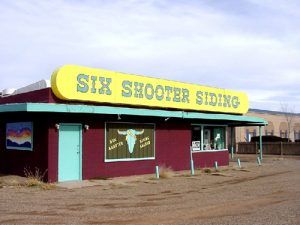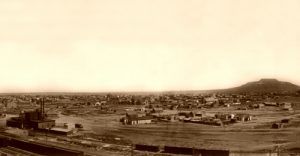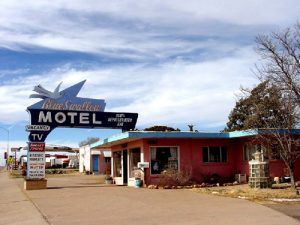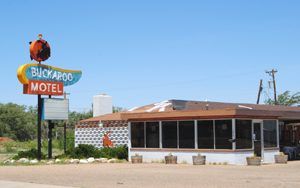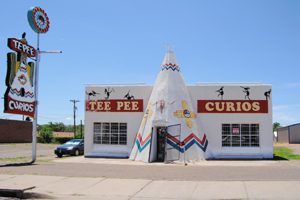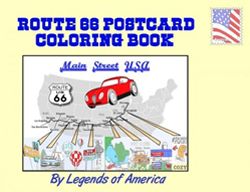Once nicknamed “Six-Shooter Siding,” Tucumcari, New Mexico, started as a rowdy railroad camp filled with saloons and outlaws. The camp began in 1901 when the Rock Island Railroad pushed west through the area. The small settlement of Liberty, some three miles north, wasted no time dismantling and moving closer to the railroad. Soon, the camp was filled with merchants, gamblers, saloon keepers, and dance hall girls.
The fathers of Tucumcari were five businessmen from Liberty who filed on the land, then donated 120 acres of land for the townsite. They were: M. B. Goldenberg, A. D. Goldenberg, Jacob Wertheim, J. A. Street, and Lee K. Smith. J.A. Street is credited for erecting the first tent in the new railroad camp.
The camp was officially called Douglas initially, but just one year later, the town took the name of Tucumcari to reflect the scenic Tucumcari Mountains acting as a background for the city. The meaning of the word “Tucumcari” is a loose derivation of a Comanche word for lookout.
The first passenger train arrived in Tucumcari on March 12, 1902, and before long, four passenger trains were arriving daily, two from the east and two from the west.
One of the first issues these hardy pioneers had to face was the lack of water. Initially, wells were dug into the hard ground, but failure to locate water discouraged further drilling. Therefore, water had to be hauled into the new settlement daily, costing the residents 50¢ a barrel.
Some of the first businesses to open in 1902 were the Waldorf-Astoria Hotel with rooms for $2 a day, the Monarch Saloon, as well as many other bawdy taverns, a furniture store, a livery barn, a boarding house located at First and Turner Streets, several mercantile stores, and the Exchange Bank. Max Goldenberg’s home was the first permanent home built in Tucumcari, which contained the post office.
The Elk Drug Store was established in 1906. It was owned by Drug Store Cowboy Herman Moncus, who collected a mammoth assortment of items more or less relating to the area’s history. He hung his collection from the ceiling of his drug store.
Within six years, the mesa lands around Tucumcari had been inundated by homesteaders who had arrived in Oklahoma Indian Territory too late to get land. By 1907, there were 20 small towns scattered about Tucumcari. Just three years later, in 1910, there were over 70 businesses in Tucumcari, plus a school system and several churches.
Primarily thriving from the railroad and area ranching opportunities, the town continued to prosper until the depression era. At that time, most of the 20 small towns surrounding the city were abandoned and quickly reverted to cow pastures.
However, Tucumcari hung on with new businesses created with the advent of Route 66. And in 1940, when the South Canadian River was dammed, this created some 60,000 acres of irrigated farmland. What were once cow pastures soon became rich farmland, pulling Tucumcari out of its slump.
Today, with over 6,000, Tucumcari provides several area attractions, including The Mesalands Dinosaur Museum, The Tucumcari Historical Museum, which includes a historic Route 66 exhibit, and Ute Lake State Park.
Not too far off the beaten path are sandstone rocks balancing in pinnacle formations, mesas and mountains, the cool winding water of the Canadian River, area lakes, and a variety of wildlife, including herds of pronghorn antelope and mule deer, flocks of Canadian geese, and sandhill cranes.
Tucumcari’s five-mile claim to Route 66 fame is along Tucumcari Boulevard, where travelers can glimpse what Route 66 was all about. The 1940s and 1950s flavor of the Mother Road can be seen here in Tucumcari’s treasure trove of motels, restaurants, and curio shops.
Numerous neon signs beckon the traveler to stop at the legendary Blue Swallow Motel, established in 1939, or Tee-Pee Curios trading post, a Route 66 icon, the Paradise Motel, and dozens of others.
Along your way, be sure to check out the Cactus Motor Lodge, the Westerner Drive-In, the Last Motel, the Pine Lodge, the Palomino Motel, Del’s Restaurant, the Town House and Safari Motels, the Sahara Sands Motel & Restaurant, Dick’s Auto Service, the Pow Wow Restaurant, the Buckaroo Motel, the Redwood Lodge and the Paradise Motel.
The Tucumcari-Quay County Chamber of Commerce has a wonderful, four-color brochure on Route 66, so be sure to ask for a copy at either the museum or the Chamber’s office. The brochure outlines a special Route 66 history tour of Tucumcari.
Tucumcari is truly a Route 66’rs delight. Be sure to allow yourself plenty of time as you stop to snap dozens of pictures before heading on down the road to Montoya and Santa Rosa.
© Kathy Alexander/Legends of America, updated May 2022.
Also See:


